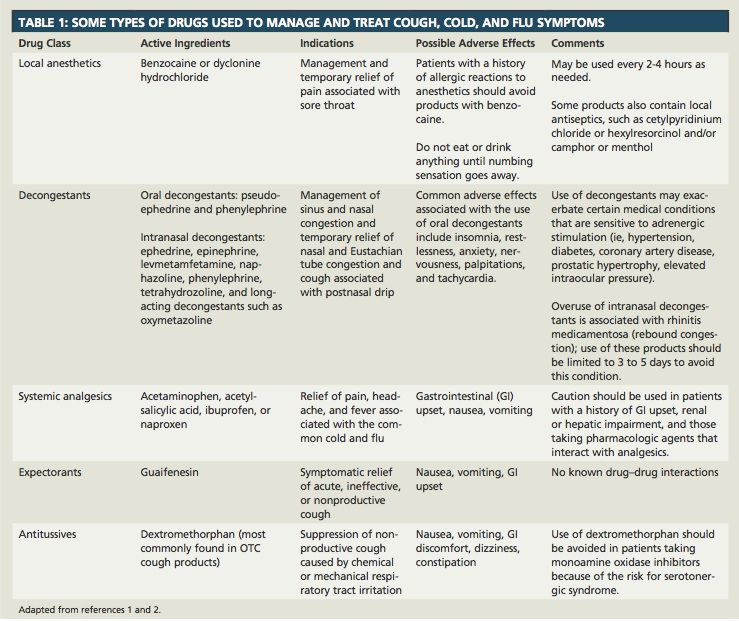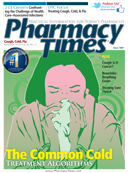Publication
Article
Pharmacy Times
OTC Cough, Cold, and Flu Products: Finding Symptomatic Relief
Author(s):
At this time of the year, patients are likely to seek counsel regarding the plethora of nonprescription products available to treat and manage cough, cold, and flu symptoms.
At this time of the year, patients are likely to seek counsel regarding the plethora of nonprescription products available to treat and manage cough, cold, and flu symptoms.
Pharmacists can be an indispensable resource in aiding patients in the selection and proper use of these nonprescription products, especially those with preexisting medical conditions or those taking other medications.
Available Products
Nonprescription products for the symptomatic relief of common symptoms associated with cough, cold, and flu include decongestants, antihistamines, expectorants, cough suppressants, antipyretics/ analgesics, and anesthetic/antiseptic products (Table 11,2). These products are available in an assortment of dosage forms to meet the needs of various patient populations. Formulations range from single-entity products to treat individual symptoms to multi-ingredient (combination) products for multisymptom relief (Online Table 2). Patients taking combination products should be advised to use only products that contain ingredients intended to treat their specific symptoms. Before recommending any OTC cough, cold, or flu product, pharmacists should evaluate the patient’s symptoms as well as his or her medical and allergy history and should screen for potential drug interactions or contraindications. In addition to cough, cold, and flu preparations formulated especially for children, some products are formulated specifically for patients with diabetes; these medications are free of sugar, alcohol, dextrose, sucrose, sorbitol, sodium, fructose, glycerin, and dyes. Also available is a line of products marketed for patients with hypertension, such as decongestantfree Coricidin HBP products (Schering-Plough HealthCare).

Medication Guidance and Recommendations
To avoid therapeutic duplication or excessive dosing, patients should be reminded to read labels before taking any medication and to check the product ingredients, especially when taking multiple products. It is also imperative that patients adhere to the recommended dosage, administration, and duration of use guidelines for the specific product they are taking. It is particularly critical to remind parents
and caregivers to read all labels prior to administering medications to children to ensure proper dosage and accuracy and to use calibrated measuring devices when administering liquids. Children should only be given nonprescription products that are manufactured specifically for the pediatric population; when in doubt regarding the appropriateness or dose of a medication, parents and caregivers should consult their pediatrician or pharmacist. Pregnant and lactating women and those with chronic medical conditions should always confer with their primary health care provider prior to taking any nonprescription medication.
Other Important Advice
Pharmacists should also seize the opportunity to stress the importance of obtaining a yearly flu vaccination and to suggest nonpharmacologic measures that may help provide relief of cold and flu symptoms, such as the use of vaporizers or humidifiers, saline nasal sprays, or nonmedicated nasal strips to relieve nasal congestion. Patients should also be advised to maintain adequate hydration and rest. In addition, they should be encouraged to seek medical attention from their primary health care provider if they experience any of the following:
• Persistent sore throat
• Cough lasting longer than 14 days
• Worsening or lingering symptoms
• High fever
• Signs of infection
• Shortness of breath
• Signs of dehydration
Studies have shown that the implementation of various preventive measures— including routine hand washing, using an alcohol-based hand sanitizer when soap and water are not available, avoiding direct contact with an individual who has a cold or the flu, and always sneezing or coughing into a tissue and not into the hand—have been effective in potentially decreasing or preventing the transmission of colds and flu.
TABLE 2: NONPRESCRIPTION COLD AND FLU PRODUCTS
Category
Brand Name
Lozenges/sprays/liquids for sore throat
· CÄ“pacol lozenges
· CÄ“pastat lozenges
· Chloraseptic lozenges, sprays, medicated strips
· Hall’s lozenges
· Ricola herb lozenges
· Sucrets lozenges
· Tylenol Cold Sore Throat liquid
Decongestants
Systemic decongestants
· Children’s Sudafed PE
· Sudafed
Intranasal decongestants
· Afrin Nasal Spray
· Little Noses Decongestant Nose Drops
· Mucinex Nasal Spray
· Sudafed OM Sinus Congestion Nasal Spray
· Neosynephrine Nasal Spray
· Vicks Sinex Nasal Spray
Nasal decongestant inhalers
· Benzedrex Inhaler
· Vicks Vapor Inhaler
Combination products
· Advil Cold and Sinus
· Advil Congestion Relief
· Aleve D Sinus and Cold
· Alka Seltzer Mucus and Congestion
· Alka Seltzer Plus Cold and Sinus
· Alka Seltzer Plus D Multi-symptom Sinus and Colda
· Coricidin HBP
· Dimetapp Cold and Cough
· Dimetapp Nighttime Cold and Congestion
· Mucinex D
· Mucinex DM
· Mucinex Fast-Max Cold, Flu and Sore Throat
· Mucinex Fast-Max Severe Cold
· Mucinex Multi Symptom Cold
· Pediacare Children’s Fever Reducer Plus Flu
· Vicks Dayquil
· Vicks Dayquil Nature Fusion Cold & Flu
· Vicks Nyquil Cold & Flu
· Vicks Pediatric Formula 44e Cough & Chest Congestion Relief
· Theraflu Cold and Flu products
· Triaminic Chest & Nasal Congestion
· Triaminic Cold & Cough
· Tylenol Cold
Ms. Terrie is a clinical pharmacy writer based in Haymarket, Virginia.
References
- Scolaro K. Disorders related to colds and allergy. In: Krinsky D, Berardi R, Ferreri S, et al, eds. Handbook of Nonprescription Drugs. 17th ed. Washington, DC: American Pharmacists Association; 2012.
- Tietze K. Cough. In: Krinsky D, Berardi R, Ferreri S, et al, eds. Handbook of Nonprescription Drugs. 17th ed. Washington, DC: American Pharmacists Association; 2012.







